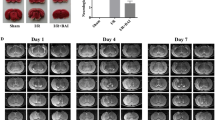Abstract
Objectives
Chunghyuldan (CHD), a combinatorial drug that has anti-hyperlipidemic and antiinflammatory activities, has been shown to reduce infarct volume in a focal ischemia-reperfusion rat model. To explore the molecular basis of CHD’s neuroprotective effect, we examined whether CHD shows a cell-protective activity and has a regulatory effect on Bax and/or B-cell leukemia/lymphoma 2 (Bcl-2) expression in mouse neuroblastoma 2a (N2a) cells subjected to hypoxia-reoxygenation (H/R).
Methods
In order to evaluate the effects of CHD on the cytotoxicity induced from hypoxia or H/R condition, lactate dehydrogenase (LDH) assay was performed. To explore whether the suppression of neural damage when pre-treated with CHD is associated with its anti-apoptotic effect, the CHD effect on the expression of Bcl-2 and Bax was analyzed by Western blotting analysis.
Results
Cytotoxicity of N2a cell line was slightly increased in 42 h hypoxia condition and dramatically increased under the H/R condition. CHD treatment markedly decreased the cytotoxicity in both conditions (P<0.01, P<0.05). H/R markedly increased the expression of the pro-apoptotic protein, Bax, but slightly increased the expression of the anti-apoptotic protein, Bcl-2, compared with the normoxia or hypoxia group. CHD significantly decreased Bax expression (P<0.01) and slightly decreased Bcl-2 expression (P>0.05), resulted in a reduction of Bax/Bcl-2 ratio in N2a cells subjected to H/R.
Conclusion
CHD has neuroprotective effect in N2a cells subjected to H/R, which might be derived at least in part from its ability to decrease the expression of the pro-apoptotic protein, Bax.
Similar content being viewed by others
References
Korea National Statistical Office. The korean annual report on causes of death in 2007. http://epic.kdi.re.kr/epic_attach/2008/D0809015.hwp
Rosamond W, Flegal K, Furie K, Go A, Greenlund K, Haase N, et al. Heart disease and stroke statistics-2008 update: a report from the American Heart Association Statistics Committee and Stroke Statistics Subcommittee. Circulation 2008;117:e25–e146.
Lee JM, Grabb MC, Zipfel GJ, Choi DW. Brain tissue responses to ischemia. J Clin Invest 2000;106:723–731.
Gonzalez RG, Hirsch JA, Koroshetz, WJ, Lev MH, Schaeferet P. Acute ischemic stroke. Imaging and Intervention. Berlin/Heidelberg: Springer-Verlag; 2006.
Hengartner M. The biochemisty of apoptosis. Nature 2000;407:770–776.
Park SU, Jung WS, Moon SK, Ko CN, Cho KH, Kim YS, et al. Chunghyuldan activates NOS mRNA expression and suppresses VCAM-1 mRNA expression in human endothelial cells. Can J Physiol Pharmacol 2005;83:1101–1108.
Cho KH, Kim YS, Bae HS, Moon SK, Jung WS, Park EK, et al. Inhibitory effect of Chunghyuldan in prostaglandin E2 and nitric oxide biosynthesis of lipopolysaccharide-induced RAW 264.7 cells. Biol Pharm Bull 2004;27:1810–1813.
Park SU, Jung WS, Moon SK, Ko CN, Cho KH, Kim YS, et al. Chunghyul-dan (Qingxie-dan) improves arterial stiffness in patients with increased baPWV. Am J Chin Med 2006;34:553–563.
Cho K, Noh K, Jung W, Park S, Moon S, Park J, et al. A preliminary study on the inhibitory effect of Chunghyul-dan on stroke recurrence in patients with small vessel disease. Neurol Res 2008;30:655–658.
Cho KH, Oh JK, Jang YS, Jung JW, Oh HR, Park EK, et al. Combination drug therapy using edaravone and Daio-Orengedoku-to after transient focal ischemia in rats. Methods Find Exp Clin Pharmacol 2008;30:443–450.
Kim YS, Jung EA, Shin JE, Chang JC, Yang HK, Kim NJ, et al. Daio-Orengedokuto inhibits HMG-CoA reductase and pancreatic lipase. Biol Pharm Bull 2002;25:1442–1445.
Nagasawa H, Kogure K. Efficacy of Oren-Gedoku-To in a chronic model of cerebral ischemia. In: Recent advances in the pharmacology of Kampo (Japanese herbal) medicines. In: Hosoya E, Yamamura Y, eds. Excerpta Medica: Tokyo; 1988:223–226.
Hwang YS, Shin CY, Huh Y, Ryu JH. Hwangryun-Hae-Doktang (Huanglian-Jie-Du-Tang) extract and its constituents reduce ischemia-reperfusion brain injury and neutrophil infiltration in rats. Life Sci 2002;71:2105–2117.
Sekiya N, Kainuma M, Hikiami H, Nakagawa T, Kouta K, Shibahara N, et al. Oren-gedoku-to and Keishi-bukuryo-ganryo inhibit the progression of atherosclerosis in diet-induced hypercholesterolemic rabbits. Biol Pharm Bull 2005;28:294–298.
Yokozawa T, Chen CP, Tanaka T. Direct scavenging of nitric oxide by traditional crude drugs. Phytomedicine 2000;6:453–463.
Yim TK, Wu WK, Mak DH, Ko KM. Myocardial protective effect of an anthraquinone-containing extract of Polygonum multiflorum ex vivo. Planta Med 1998;64:607–611.
Green DR, Reed JC. Mitochondria and apoptosis. Science 1993;281:1309–1312.
Zamzami N, Susin SA, Marchetti P, Hirsch T, Gómez-Monterrey I, Castedo M, et al. Mitochondrial control of nuclear apoptosis. J Exp Med 1996;183:1533–1544.
Kluck RM, Bossy-Wetzel E, Green DR, Newmeyer DD. The release of cytochrome c from mitochondria: a primary site for Bcl-2 regulation of apoptosis. Science 1997;275(5303):1132–1136.
Kroemer G, Dallaporta B, Resche-Rigon M. The mitochondrial death/life regulator in apoptosis and necrosis. Annu Rev Physiol 1998;60:619–642.
Reed JC. Double identity for proteins of the Bcl-2 family. Nature 1997;387:773–776.
Pastorino JG, Chen ST, Tafani M, Snyder JW, Farber JL. The overexpression of Bax produces cell death upon induction of the mitochondrial permeability transition. J Biol Chem 1998;273:7770–7775.
Jürgensmeier JM, Xie Z, Deveraux Q, Ellerby L, Bredesen D, Reed JC. Bax directly induces release of cytochrome c from isolated mitochondria. Proc Natl Acad Sci USA 1998;95:4997–5002.
Saeed SA, Shad KF, Saleem T, Javed F, Khan MU. Some new prospects in the understanding of the molecular basis of the pathogenesis of stroke. Exp Brain Res 2007;182:1–10.
Lee YS, Kang YJ, Kim HJ, Park MK, Seo HG, Lee JH, et al. Higenamine reduces apoptotic cell death by induction of hemeoxygenase-1 in rat myocardial ischemia-reperfusion injury. Apoptosis 2006:11;1091-1100.
Author information
Authors and Affiliations
Corresponding author
Rights and permissions
About this article
Cite this article
Ko, CN., Park, IS., Park, SU. et al. Neuroprotective effect of Chunghyuldan (Qing Xue Dan) on hypoxia-reoxygenation induced damage of neuroblastoma 2a cell lines. Chin. J. Integr. Med. 19, 940–944 (2013). https://doi.org/10.1007/s11655-013-1657-6
Received:
Published:
Issue Date:
DOI: https://doi.org/10.1007/s11655-013-1657-6




